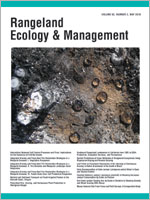Plant functional types (PFT) have been used to describe the response of native vegetation to environmental factors (i.e., fertility) and to livestock disturbance, but rarely under conditions of continuous grazing. In this work we investigate whether the long-term response of grassland communities submitted to a gradient of continuous grazing pressure can be described with such an approach. After 15 yr of differentiation of the grazing pressure applied to native grasslands we measured leaf dry-matter content (LDMC) and specific leaf area (SLA) of Poaceae populations of the communities. A grazing pressure gradient was created by levels of daily forage allowance: 4, 8, 12, and 16 kg of dry matter per day per 100 kg of animal live weight, monitored monthly. PFTs were defined by numerical analysis, where an algorithm finds the optimal trait subset based on the agreement between matrices of species × traits, paddocks × grass biomass, and environmental variables (levels of forage allowance and soil characteristics). The results show that it is possible to describe a gradient of grazing pressure by means of LDMC and/or SLA measured only on the Poacea contributing at least 80% of the total Poaceae biomass. Four PFTs were differentiated by these leaf traits. PFTs having low LDMC and high SLA are characteristic of high intensity of use and are made up largely of stoloniferous C4 species typical of rapid resource capture strategies. Conversely, PFTs characterized by high LDMC and low SLA include species that are representative of low grazing pressure. Variations in the aggregate value of traits are due to changes in the species proportions and not to leaf-size adaptation as hypothesized. We conclude than in the absence of a gradient of fertility, plants with strategies of resource capture tend to be more represented under high grazing pressures. This situation results in a loss of functional diversity, but in particular a reduction in forage availability, which is incompatible with high animal production.
How to translate text using browser tools
1 May 2010
Leaf Traits as Functional Descriptors of the Intensity of Continuous Grazing in Native Grasslands in the South of Brazil
Pablo Cruz,
Fernando Luis F. De Quadros,
Jean Pierre Theau,
Adriana Frizzo,
Claire Jouany,
Michel Duru,
Paulo Cesar F. Carvalho
ACCESS THE FULL ARTICLE

Rangeland Ecology and Management
Vol. 63 • No. 3
May 2010
Vol. 63 • No. 3
May 2010
grazing pressure
Leaf dry matter content
Plant functional types
Poacea
specific leaf area




